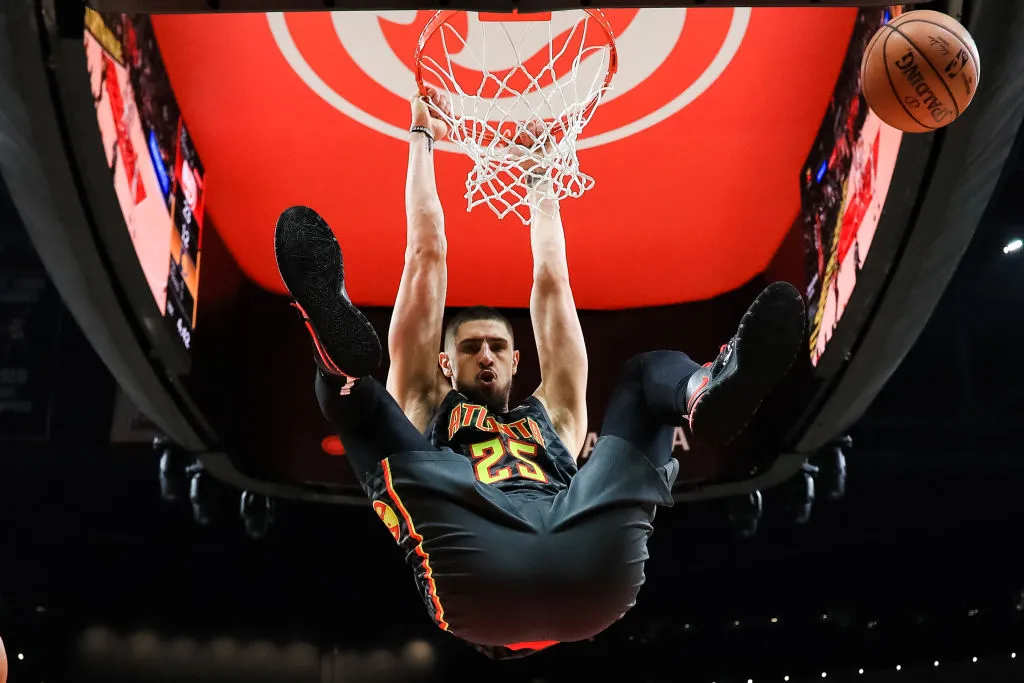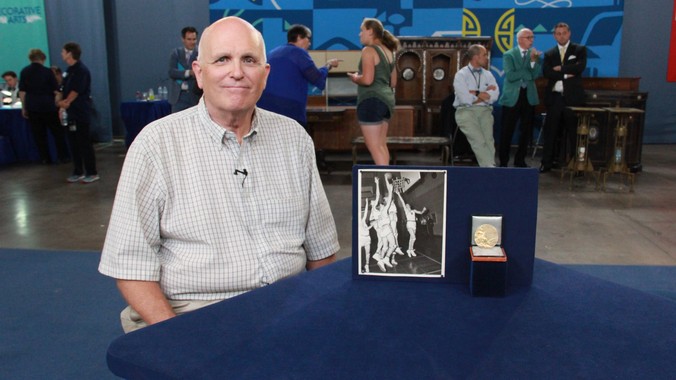
The slam dunk, basketball’s most thrilling and gravity-defying play, has a rich and complex history. From the NBA’s All-Star weekends to streetball courts, the dunk hogs the spotlight, captivating fans and players alike.
But who made the first dunk in the NBA? This question takes us on a journey back to the game’s cagey beginnings, where backboards were optional, and some games were waged in literal cages. The answer lies in the actions of two individuals: Jack Inglis, who performed the first slam dunk with the help of a cage, and Joe Fortenberry, the first documented player to dunk in an organized game.
Early History of the Dunk
Way back in the early days of basketball, Jack Inglis made history by performing the first slam dunk. According to author Bill Gutman, Inglis jumped up alongside the basket, grabbed the cage, and pulled himself up. While defenders looked up helplessly, a teammate passed him the ball. Inglis caught it with one hand while hanging onto the cage and dropped it through the basket.
This cage-assisted dunk marked the inception of what would become basketball’s marquee move. Shortly after, in the lead-up to the 1936 Olympic Games in Berlin, 6-foot-8 Joe Fortenberry dunked the ball in an organized game, pitching it downward into the hoop, much like dunking a roll in coffee. Fortenberry’s dunk, performed in short-shorts during training, set a precedent that would influence the game for generations to come.
Joe Fortenberry: The Pioneer of Dunking
Joe Fortenberry, a farm boy from Happy, Texas, stood tall at 6-foot-8 and possessed a unique ability to dunk the basketball. Playing for the McPherson Globe Refiners, Fortenberry’s dunking style was unorthodox yet effective. He would leap towards the hoop, extend his arm, and pitch the ball downward into the basket. This technique, likened to dunking a roll in coffee, earned him recognition as the pioneer of dunking in organized basketball.

Fortenberry’s influence extended beyond the court, leading to the introduction of the goaltending rule, which prohibited players from blocking a shot on its way down. His actions in the 1936 Olympic Games paved the way for future generations of dunkers, setting a precedent that would shape the game’s evolution.
The Evolution of Dunks
The 1940s and ’50s saw the emergence of Bob Kurland, a 7-foot center for Oklahoma A&M, who became known for regularly dunking the ball during games. Kurland’s dominance led to an unwritten rule among coaches, discouraging the slam dunk. The NCAA even went as far as banning the slam prior to the 1967-68 college season.
However, the 1960s and ’70s marked a resurgence in creative dunking, with players like Julius “Dr. J” Erving taking the art to new heights. Dr. J’s soaring slam dunks and graceful flights captivated fans and inspired a new generation of players. The dunk had evolved from a simple score to a statement of skill, style, and individual expression.
The NBA Slam Dunk Contest and Modern Dunking
The NBA Slam Dunk Contest, an annual event held during the NBA’s All-Star weekend, has become a showcase for creativity, athleticism, and showmanship. It all began with the American Basketball Association (ABA) hosting the first-ever dunk contest in 1976, featuring stars like Julius Erving and David Thompson. Dr. J’s iconic free-throw line dunk in that contest set the stage for what would become one of the NBA’s most anticipated events.

Following the ABA-NBA merger, the NBA introduced its own Slam Dunk Contest in 1984. The early years of the contest saw Dominique Wilkins and Michael Jordan battling for supremacy, with Wilkins winning in 1985 and Jordan claiming victory in 1987 and 1988. Their head-to-head duels, filled with acrobatic dunks and fierce competition, helped elevate the contest’s status.
The 1990s brought new stars to the forefront, with players like Dee Brown, who won in 1991 with his famous “no-look” dunk, and Kobe Bryant, who became the youngest winner ever in 1997 at the age of 18. Vince Carter’s performance in the 2000 contest is often regarded as the greatest in dunk contest history, with his “Elbow Dunk” and “360 Windmill” leaving fans and fellow players in awe.
In recent years, the contest has continued to evolve, with innovative dunks and engaging storylines. Nate Robinson, standing at just 5-foot-9, won the contest three times (2006, 2009, 2010), showcasing his incredible leaping ability. Zach LaVine and Aaron Gordon’s epic duel in 2016, featuring multiple perfect-score dunks, reinvigorated interest in the contest.
This will forever be the cleanest dunk in NBA history pic.twitter.com/bYnMghueLY
— Big Knick Energy (@BigKnickEnergy_) August 16, 2023
The Slam Dunk Contest has also seen its share of surprises, with lesser-known players like Jeremy Evans (2012) and Hamidou Diallo (2019) capturing the title. The contest’s format has changed over the years, with various scoring systems, rounds, and fan voting, reflecting the league’s efforts to keep the event fresh and exciting.
The NBA Slam Dunk Contest’s rich history, filled with iconic moments, legendary players, and groundbreaking creativity, reflects the game’s growth and the players’ relentless pursuit of excellence. From Dr. J to Michael Jordan, Vince Carter to Zach LaVine, the contest continues to captivate fans, celebrate individuality, and push the boundaries of what’s possible on a basketball court.
The Cultural Impact of Dunking
The slam dunk’s influence extends beyond the hardwood, permeating popular culture and resonating with fans worldwide. Its comparison with skateboard culture, where tricks and creativity reign supreme, underscores the dunk’s role as a form of self-expression. The dunk’s electrifying nature has contributed to making basketball the world’s second most popular sport.

From Vince Carter’s “Elbow Dunk” to Michael Jordan’s “Free-Throw Line Dunk,” these iconic moments have become cultural touchstones. The influence of dunking on fan engagement and entertainment is undeniable. Whether in NBA arenas or streetball courts, the dunk continues to inspire, entertain, and challenge the boundaries of human athleticism.
Final Thoughts
The journey of the slam dunk, from its cagey beginnings with Jack Inglis to Joe Fortenberry’s pioneering dunk, and through the eras of Bob Kurland, Julius “Dr. J” Erving, Michael Jordan, and Vince Carter, paints a vivid picture of basketball’s evolution. The dunk has transformed from just a spontaneous play and simple scoring method to a symbol of power, grace, creativity, and individuality. Its impact on the game, the fans, and the culture at large is profound and enduring.
The slam dunk’s history is a testament to the dynamism and complexity of basketball. It reflects the sport’s ability to innovate, entertain, and inspire. The dunk’s rich tapestry, woven with iconic moments, legendary players, and groundbreaking contests, continues to add depth and intrigue to the game. Whether building championship teams or creating unforgettable highlights, the slam dunk stands as a thrilling and timeless element of basketball.
Frequently Asked Questions
Did Muggsy Bogues ever dunk in the NBA?
Muggsy Bogues, standing at 5-foot-3 and known as the shortest player in NBA history, never officially dunked in an NBA game. While there have been reports of him dunking during practice sessions, there is no documented evidence of Bogues performing a dunk during an official NBA game.
Who did the first free-throw dunk?
The first free-throw line dunk is attributed to Julius “Dr. J” Erving. He performed this iconic dunk during the 1976 ABA Slam Dunk Contest. Dr. J’s free-throw line dunk became one of the most memorable dunks in basketball history and set the stage for future players like Michael Jordan to replicate the feat.
Who was the first 360 dunk in the NBA?
The origin of the first 360 dunk in the NBA is not well-documented, and attributing it to a specific player is challenging. The 360 dunk, involving a complete spin in the air before dunking, has been performed by many players over the years playing basketball. Some of the early practitioners of the 360 dunk include legends like Dominique Wilkins, known for his acrobatic and powerful dunks.
Sources
1. sportscasting.com – Who Was the First NBA Player to Dunk?
2. wikipedia.org – Slam dunk
3. theguardian.com – The history of the slam dunk: from outlawed move to beloved highlight
4. bleacherreport.com – 30 Years Later: An Oral History of the NBA’s First Slam Dunk Contest
5. redbull.com – Slam Dunk History: The history of Basketball’s marquee move
6. nothingbutnylon.com – Who Was the First Player to Dunk?





